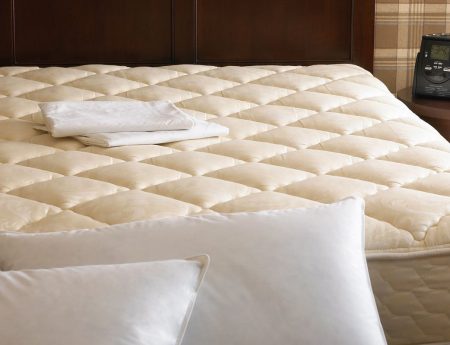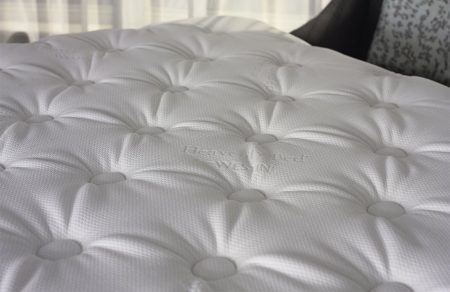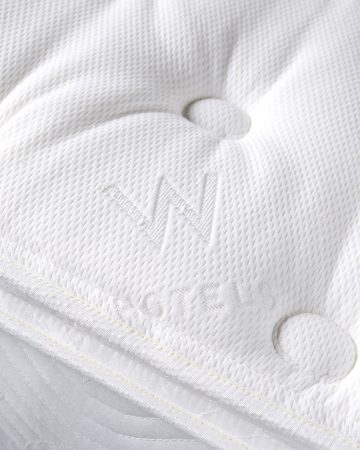|
|
|
|
| Performance Factor |
Criteria |
Foam Mattress Rating |
Innerspring Rating |
Hybrid Rating |
| Durability |
The average mattress needs to be replaced after seven years of continuous use. |
Good -
Foam/memory foam beds have an expected lifespan of about 6.5 to 7 years, which is comparable to the average mattress. |
Fair -
Innersprings are more susceptible to sagging and early deterioration; expect to replace an innerspring bed after six years of regular use. |
Fair to Good -
Hybrids tend to be slightly more durable than innersprings, but their expected lifespan is about six and a half years – which is lower than average. |
| Conforming ability |
Some beds hug the body closely while others conform very little, but the best beds conform consistently to the sleeper’s heaviest and lightest areas. |
Very Good -
Most memory foam mattresses offer consistent conforming, regardless of the firmness; a wide range of firmness options ensures most sleepers can find a suitable model. |
Poor to Fair -
Many innersprings are constructed with thin comfort layers of standard polyfoam; the materials may conform closely but usually inconsistently, and the beds are more susceptible to sagging and wear. |
Good -
Because they contain conforming comfort layers of memory foam and/or latex, most hybrids have a fairly consistent conforming ability and provide comfortable weight distribution. |
| Pain/pressure relief |
Mattresses that maintain a supportive, sag-free structure and conform consistently typically alleviate the most discomfort in sleepers. |
Very Good -
Many sleepers find that memory foam provides the highest levels of pain and pressure relief – though choosing the right firmness is essential. |
Fair -
Innersprings may alleviate discomfort for some sleepers, but pain and pressure relief potential is minimal compared to other mattress types. |
Good to Very Good -
Many hybrids – particularly those with thicker comfort systems – alleviate aches and pains to the same extent as all-foam beds. |
| Support - |
Beds that maintain an even, flat surface with very little sagging provide the best support for sleepers. |
Fair to Good -
Mattress foam softens over time, often leading to sagging in areas that usually support the sleeper’s heaviest areas, but beds with thick, high-density base layers can withstand sagging reasonably well. |
Good -
Support is a key strength of innersprings, especially for models with lower-gauge coils and reinforcement foam in the support core; however, many innersprings begin sagging after a few years of use. |
Good -
Like innersprings, hybrids are susceptible to early sagging, butmost provide average to above-average support; this is particularly true for models with high-density foam encasing the pocketed coils. |
| Temperature neutrality |
Some mattresses absorb body heat from sleepers, causing them to feel excessively hot or warm, while others regulate temperature well and sleep fairly cool. |
Poor to Fair -
Mattress foam retains a fair amount of body heat and often sleeps hot; some manufacturers infuse their foams with gel, graphite, and other cooling materials to mitigate this issue, but some sleepers still find the beds uncomfortably warm. |
Good to Very Good -
Innerspring mattresses circulate air through the coil layer(s) fairly well, resulting in consistent temperature regulation and cool, comfortable sleep for most. |
Good -
Hybrids also circulate air through their coil layers very well, but memory foam/latex comfort layers may absorb body heat from sleepers and counteract the airflow to some extent. |
| Motion Isolation |
Some mattresses are engineered to isolate motion transfer whenever someone gets into/out of bed or switches positions, which can reduce sleep disruptions for couples. |
Very Good to Excellent -
Most all-foam beds isolate motion transfer to a very noticeable extent. |
Poor to Fair -
Most innersprings are quite responsive, resulting in noticeable transfer whenever movement occurs. |
Good -
Though hybrids can be responsive, their thick comfort layers often absorb and isolate transfer to a noticeable extent. |
| Sex |
Mattresses that respond to movement tend to be the best for sex; those that conform closely to sleepers can cause uncomfortable sinking sensations. |
Fair -
Mattress foam is not very responsive; unless the mattress is exceptionally firm, it will likely cause sleepers to sink during sex. |
Very Good to Excellent -
Innersprings are considered by many to be the best for sex, as they are highly responsive to movement and very springy. |
Good to Very Good -
Hybrids can be fairly responsive and suitable for some couples, though their foam/latex layers make them less responsive than innersprings. |
| Noise potential |
Most mattresses made today are fairly quiet, but some internal components can squeak, creak, or make other disruptive sounds. |
Excellent -
With rare exception, all-foam mattresses are virtually silent when bearing weight. |
Poor to Fair -
The coils in innersprings often squeak when bearing weight, and may also produce sounds when someone moves. |
Good -
Hybrids have pocketed coils, which tend to be quieter than other spring types – but squeaks and creaks may occasionally occur. |
| Odor potential |
All new mattresses emit VOCs that cause off-gassing odor, but some are associated with stronger and/or more persistent smells than others. |
Fair -
Many all-foam beds emit initial odors that persist over time, but few are associated with excessive smells that affect the owner’s experience. |
Very Good to Excellent -
Because innersprings circulate air very well, most off-gassing odors dissipate in a matter of days. |
Good to Very Good -
A hybrid’s odor potential often depends on the thickness and materials in its comfort system, but most models are not associated with inordinately strong smells. |
| Edge support |
Mattresses may develop sinkage along the perimeter where owners tend to sit, but some beds are equipped with safeguards to prevent the edges from wear. |
Poor to Fair -
Some all-foam beds have thick, high-density foam bases that help protect the edges, but most develop sinkage along the perimeter after a few years of use. |
Very Good to Excellent -
In many innersprings, the coils act as a load-bearing layer that reinforces the edges and minimizes sinkage over time. |
Very Good -
Pocketed coils are not as resilient or strong as other coil types, but many hybrids today have coils encased in high-density foam for added edge support. |
| Average price range (Queen) |
The average mattress costs $1,100 in a Queen size |
$700 to $1,300 -
Foam mattresses have relatively inexpensive price-points compared to other bed types. |
$600 to $1,200 -
Innersprings have the lowest average price-point among all five major mattress types. |
$1,300 to $2,000 -
Hybrids have a fairly high average price-point, though they are less expensive than latex or airbed mattresses. |
|
|
|
|


